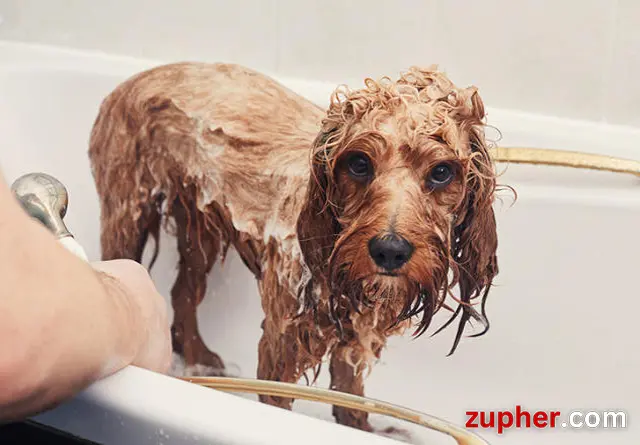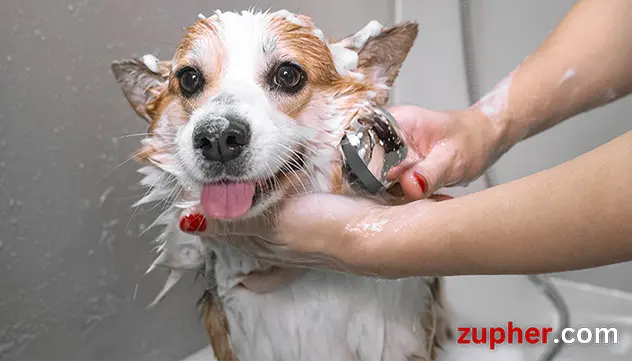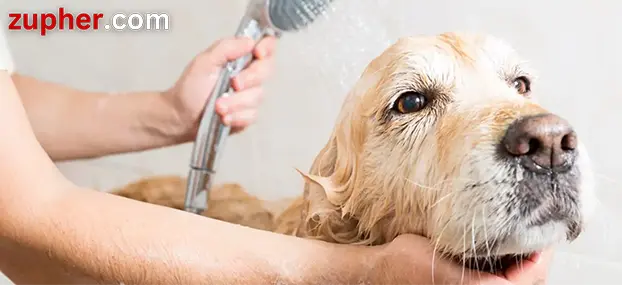How often should you bathe your dog?

Introduction
A. Importance of Proper Dog Hygiene
Taking care of your dog’s cleanliness is vital for their health and happiness. Just like us, dogs need regular grooming to stay clean and free from dirt and germs.
B. Overview of Bathing Frequency Considerations
Deciding how often to bathe your furry friend depends on various factors such as their breed, activity level, and skin condition. It’s essential to find the right balance to keep them clean without drying out their skin or stripping away natural oils. Let’s explore the factors that influence how often your dog needs a bath.

Understanding Your Dog’s Skin and Coat
A. Different Coat Types and Their Specific Needs
Dogs vary in size and shape, and their coats also exhibit diversity. Some have short, smooth fur, while others have long, fluffy hair. Understanding your dog’s coat type helps determine how often they need a bath. For example, dogs with oily coats might need more frequent baths to keep them clean.
B. Impact of Breed, Activity Level, and Environment on Coat Condition
Factors like your dog’s breed, how much they play outside, and where you live can affect their coat condition. For instance, if your dog spends a lot of time outdoors, they might get dirtier quickly and need more baths. Similarly, certain breeds with thick coats might need extra grooming to prevent mats and tangles.
C. Signs of Over-bathing or Under-bathing
Bathing your dog too frequently can strip away their natural oils, leading to dry, itchy skin. On the other hand, not bathing them enough can result in a smelly, dirty pooch. It’s essential to find the right balance. Signs of over-bathing include dry, flaky skin, while signs of under-bathing include a strong odor and dirty fur.

Factors Influencing Bathing Frequency
A. Skin Conditions and Allergies
Some dogs have sensitive skin or allergies that require special care. Bathing too frequently or using harsh shampoos can irritate their skin, while not bathing them enough can lead to skin infections. It’s essential to consult with your veterinarian to determine the best bathing frequency for your pup’s specific needs.
B. Outdoor Exposure and Activities
Dogs who spend a lot of time outdoors, especially in muddy or dusty environments, may need more frequent baths to remove dirt and debris from their fur. Additionally, dogs who love to swim might need baths to wash away chlorine or saltwater that can dry out their skin.
C. Seasonal Variations and Weather Conditions
During hot and humid weather, dogs may sweat more and develop a stronger odor, necessitating more frequent baths. Conversely, in colder months, dogs may not need baths as often since they’re less likely to get dirty or sweaty. Adjusting bathing frequency based on seasonal changes helps keep your dog comfortable and clean.
D. Specific Health Concerns or Medical Recommendations
Certain health conditions, such as skin infections or parasites, may require more frequent baths as part of their treatment plan. Your veterinarian may recommend medicated shampoos or specific bathing routines to help manage these conditions effectively. Always follow your vet’s advice when it comes to your dog’s health and grooming needs.

Guidelines for Bathing Frequency
A. General Recommendations from Veterinarians and Grooming Experts
Veterinarians and grooming experts suggest bathing your dog every few weeks to monthly, depending on their needs. However, this can vary based on factors like breed, activity level, and skin condition.
B. Customizing Bathing Schedule Based on Individual Dog Characteristics
Every dog is unique, so it’s essential to tailor their bathing schedule to fit their specific needs. Consider factors such as coat type, skin sensitivity, and lifestyle when deciding how often to bathe your furry friend.
C. Importance of Using Dog-Specific Shampoos and Conditioners
Using products specifically formulated for dogs is crucial for maintaining their skin and coat health. Human shampoos can be too harsh for dogs and may strip away natural oils, leading to skin irritation. Dog-specific shampoos and conditioners help keep their fur clean and shiny without causing any harm.
D. Techniques for Effective Bathing and Minimizing Stress
When bathing your dog, it’s essential to use gentle techniques to minimize stress and make the experience more enjoyable for them. Start by brushing their coat to remove any mats or tangles, then use lukewarm water and gentle massage motions to lather the shampoo. Rinse thoroughly to ensure all shampoo is removed, and dry them off with a towel or blow dryer on a low setting.

Signs of Excessive Bathing or Inadequate Hygiene
A. Common Skin and Coat Issues Related to Improper Bathing
Bathing your dog too frequently or using the wrong products can lead to various skin and coat problems. These may include dry, flaky skin, excessive itching, redness, and even infections. Pay attention to any changes in your dog’s skin or coat texture after bathing to catch these issues early.
B. Behavioral Indicators of Discomfort or Irritation
Your dog might exhibit behavioral signs if they’re not comfortable with their bathing routine. These can include excessive scratching or licking, avoiding the bath area, or displaying signs of anxiety or distress during or after bathing. Monitoring your dog’s behavior can help you identify if they’re experiencing discomfort due to bathing.
C. Seeking Professional Advice for Persistent Problems
If you notice persistent skin or coat issues despite adjusting your dog’s bathing routine, it’s essential to seek professional advice from a veterinarian or groomer. They can help diagnose any underlying issues and provide guidance on the best course of action to address them effectively. Don’t hesitate to reach out for help if you’re unsure about how to manage your dog’s skin and coat problems.
Maintenance Between Baths
A. Regular Brushing and Grooming Routines
Brushing your dog’s fur regularly helps remove loose hair, dirt, and tangles, keeping their coat clean and shiny between baths. It also stimulates their skin and promotes healthy circulation.
B. Importance of Inspecting Ears, Eyes, and Paws for Cleanliness
Checking your dog’s ears, eyes, and paws regularly helps prevent infections and other issues. Wipe away any dirt or debris gently with a damp cloth and inspect for any signs of redness, discharge, or discomfort.
C. Using Dry Shampoos or Wipes for Spot Cleaning
Dry shampoos or wipes are handy for spot-cleaning your dog between baths, especially for areas that get dirty quickly, like their paws or belly. They help freshen up your dog’s coat without the need for a full bath.
D. Dietary Considerations for Promoting Healthy Skin and Coat
A balanced diet plays a crucial role in maintaining your dog’s skin and coat health. Ensure they’re getting proper nutrition with high-quality dog food that contains essential vitamins, minerals, and fatty acids. Consult with your veterinarian for recommendations tailored to your dog’s specific needs.
Conclusion
A. Emphasizing the Importance of a Balanced Approach to Dog Hygiene
Maintaining your dog’s cleanliness is crucial, but it’s essential to find the right balance. Bathing them too often can cause skin problems, while not bathing them enough can lead to hygiene issues.
B. Encouraging Owners to Observe Their Dog’s Individual Needs and Adjust Bathing Frequency Accordingly
Every dog is different, so it’s essential to pay attention to your dog’s specific needs and adjust their bathing frequency accordingly. Factors like breed, coat type, activity level, and skin condition all play a role in determining how often they should be bathed.
C. Highlighting the Role of Regular Grooming and Veterinary Care in Maintaining Overall Canine Well-being
In addition to bathing, regular grooming and veterinary care are essential for keeping your dog healthy and happy. Grooming helps prevent mats, tangles, and skin issues, while veterinary check-ups ensure any health concerns are addressed promptly. By staying proactive in your dog’s care, you can help them live a long, healthy life.
People also ask
Is it acceptable to bathe a dog weekly?
Yes, but it depends on the dog’s breed, skin condition, and lifestyle.
How often should you bathe an indoor dog?
Generally, indoor dogs need less frequent baths, around every 4-6 weeks.
How can you tell if your dog needs a bath?
Signs include a strong odor, dirty fur, or skin irritation.
Should I bathe my dog every 3 days?
Not usually necessary; it may strip natural oils from their skin.
Is it alright to shower my dog twice a week?
It’s not recommended; too frequent bathing can dry out their skin.
Can I bathe my dog every 2 days?
Generally not recommended; it can lead to skin irritation and dryness.



